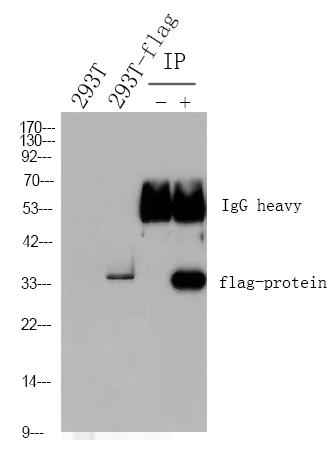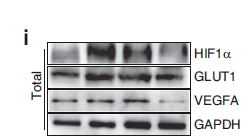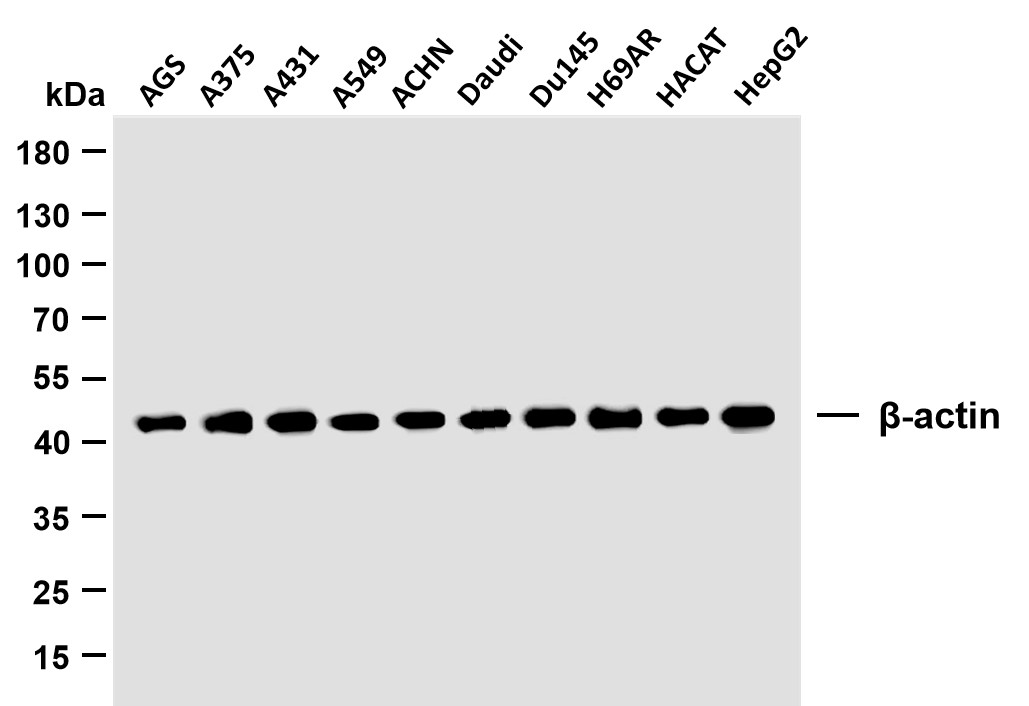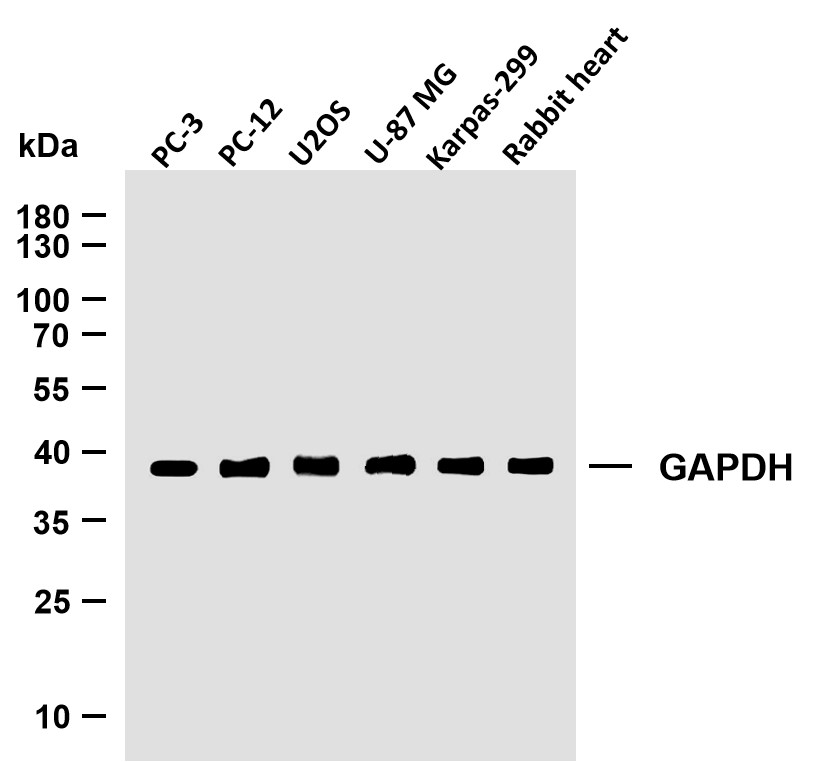
Catalog: YM0265
Size
Price
Status
Qty.
200μL
$600.00
3 weeks
0
100μL
$350.00
3 weeks
0
50μL
$210.00
3 weeks
0
Add to cart


Collected


Collect
Main Information
Target
FGF-2
Host Species
Mouse
Reactivity
Human
Applications
WB, IHC, IF, ELISA
MW
31kD (Calculated)
Conjugate/Modification
Unmodified
Detailed Information
Recommended Dilution Ratio
WB 1:500-1:2000; IHC 1:200-1:1000; ELISA 1:10000; IF 1:50-200
Formulation
Liquid in PBS containing 50% glycerol, 0.5% BSA and 0.02% sodium azide.
Specificity
FGF-2 Monoclonal Antibody detects endogenous levels of FGF-2 protein.
Purification
Affinity purification
Storage
-15°C to -25°C/1 year(Do not lower than -25°C)
MW(Calculated)
31kD
Modification
Unmodified
Clonality
Monoclonal
Related Products
Antigen&Target Information
Immunogen:
Purified recombinant fragment of FGF-2 expressed in E. Coli.
show all
Specificity:
FGF-2 Monoclonal Antibody detects endogenous levels of FGF-2 protein.
show all
Gene Name:
FGF2
show all
Protein Name:
Heparin-binding growth factor 2
show all
Other Name:
FGF2 ;
FGFB ;
Fibroblast growth factor 2 ;
FGF-2 ;
Basic fibroblast growth factor ;
bFGF ;
Heparin-binding growth factor 2 ;
HBGF-2
FGFB ;
Fibroblast growth factor 2 ;
FGF-2 ;
Basic fibroblast growth factor ;
bFGF ;
Heparin-binding growth factor 2 ;
HBGF-2
show all
Background:
The protein encoded by this gene is a member of the fibroblast growth factor (FGF) family. FGF family members bind heparin and possess broad mitogenic and angiogenic activities. This protein has been implicated in diverse biological processes, such as limb and nervous system development, wound healing, and tumor growth. The mRNA for this gene contains multiple polyadenylation sites, and is alternatively translated from non-AUG (CUG) and AUG initiation codons, resulting in five different isoforms with distinct properties. The CUG-initiated isoforms are localized in the nucleus and are responsible for the intracrine effect, whereas, the AUG-initiated form is mostly cytosolic and is responsible for the paracrine and autocrine effects of this FGF. [provided by RefSeq, Jul 2008],
show all
Function:
Function:The heparin-binding growth factors are angiogenic agents in vivo and are potent mitogens for a variety of cell types in vitro. There are differences in the tissue distribution and concentration of these 2 growth factors.,miscellaneous:This protein binds heparin more strongly than does aFGF.,PTM:Several N-termini starting at positions 48, 54, 47 and 65 have been identified by direct sequencing.,sequence Caution:Unusual initiator. The initiator methionine is coded by a non-canonical CTG leucine codon.,similarity:Belongs to the heparin-binding growth factors family.,subunit:Monomer. Interacts with CSPG4 and FGFBP1. Found in a complex with FGFBP1, FGF1 and FGF2.,tissue specificity:Expressed in granulosa and cumulus cells.,
show all
Cellular Localization:
Secreted . Nucleus . Exported from cells by an endoplasmic reticulum (ER)/Golgi-independent mechanism. Unconventional secretion of FGF2 occurs by direct translocation across the plasma membrane (PubMed:20230531). Binding of exogenous FGF2 to FGFR facilitates endocytosis followed by translocation of FGF2 across endosomal membrane into the cytosol (PubMed:22321063). Nuclear import from the cytosol requires the classical nuclear import machinery, involving proteins KPNA1 and KPNB1, as well as CEP57 (PubMed:22321063). .
show all
Tissue Expression:
Expressed in granulosa and cumulus cells. Expressed in hepatocellular carcinoma cells, but not in non-cancerous liver tissue.
show all
Research Areas:
>>EGFR tyrosine kinase inhibitor resistance ;
>>MAPK signaling pathway ;
>>Ras signaling pathway ;
>>Rap1 signaling pathway ;
>>Calcium signaling pathway ;
>>PI3K-Akt signaling pathway ;
>>Signaling pathways regulating pluripotency of stem cells ;
>>Regulation of actin cytoskeleton ;
>>Kaposi sarcoma-associated herpesvirus infection ;
>>Pathways in cancer ;
>>Proteoglycans in cancer ;
>>Chemical carcinogenesis - receptor activation ;
>>Melanoma ;
>>Breast cancer ;
>>Gastric cancer
>>MAPK signaling pathway ;
>>Ras signaling pathway ;
>>Rap1 signaling pathway ;
>>Calcium signaling pathway ;
>>PI3K-Akt signaling pathway ;
>>Signaling pathways regulating pluripotency of stem cells ;
>>Regulation of actin cytoskeleton ;
>>Kaposi sarcoma-associated herpesvirus infection ;
>>Pathways in cancer ;
>>Proteoglycans in cancer ;
>>Chemical carcinogenesis - receptor activation ;
>>Melanoma ;
>>Breast cancer ;
>>Gastric cancer
show all
Signaling Pathway
Cellular Processes >> Cellular community - eukaryotes >> Signaling pathways regulating pluripotency of stem cells
Cellular Processes >> Cell motility >> Regulation of actin cytoskeleton
Human Diseases >> Cancer: overview >> Pathways in cancer
Human Diseases >> Cancer: specific types >> Gastric cancer
Human Diseases >> Cancer: specific types >> Melanoma
Human Diseases >> Cancer: specific types >> Breast cancer
Environmental Information Processing >> Signal transduction >> MAPK signaling pathway
Environmental Information Processing >> Signal transduction >> Ras signaling pathway
Environmental Information Processing >> Signal transduction >> Rap1 signaling pathway
Environmental Information Processing >> Signal transduction >> Calcium signaling pathway
Environmental Information Processing >> Signal transduction >> PI3K-Akt signaling pathway
Reference Citation({{totalcount}})
Catalog: YM0265
Size
Price
Status
Qty.
200μL
$600.00
3 weeks
0
100μL
$350.00
3 weeks
0
50μL
$210.00
3 weeks
0
Add to cart


Collected


Collect
Recently Viewed Products
Clear allPRODUCTS
CUSTOMIZED
ABOUT US
Toggle night Mode
{{pinfoXq.title || ''}}
Catalog: {{pinfoXq.catalog || ''}}
Filter:
All
{{item.name}}
{{pinfo.title}}
-{{pinfo.catalog}}
Main Information
Target
{{pinfo.target}}
Reactivity
{{pinfo.react}}
Applications
{{pinfo.applicat}}
Conjugate/Modification
{{pinfo.coupling}}/{{pinfo.modific}}
MW (kDa)
{{pinfo.mwcalc}}
Host Species
{{pinfo.hostspec}}
Isotype
{{pinfo.isotype}}
Product {{index}}/{{pcount}}
Prev
Next
{{pvTitle}}
Scroll wheel zooms the picture
{{pvDescr}}



















